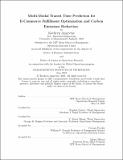Multi-Modal Transit Time Prediction for E-Commerce Fulfillment Optimization and Carbon Emissions Reduction
Author(s)
Angevine, Kathryn
DownloadThesis PDF (3.938Mb)
Advisor
Zheng, Y. Karen
Graves, Stephen
Terms of use
Metadata
Show full item recordAbstract
Consumers are purchasing an increasing amount of goods through digital channels as compared to brick and mortar and expect fast, reliable delivery. At the same time, society is facing the urgent challenge of reducing carbon emissions to limit global warming to levels considered safe by climate scientists. A global sportswear retailer is investing in improving the digital consumer experience while meeting its aggressive 2030 carbon reduction goals. This work studies how machine learning can be used to both improve the retailer’s digital fulfillment operations and reduce their carbon emissions footprint. It focuses on enhancing the decision-making used to select a distribution center to fulfill a consumer’s order from, and aims to do so by increasing the accuracy of a key input into that process. Specifically, the work targets accuracy improvement of transit time estimates, which quantify the number of days between a parcel’s carrier induction and delivery.
Machine learning techniques are leveraged to develop a model for predicting transit times. Model development begins with data preparation, which is inclusive of sourcing, cleaning, sampling and feature engineering. It then continues with a series of experiments to provide insights into favorable model design elements. A final model is created under consideration of experimentation results. This model is associated with an accuracy of 67%, which is a improvement beyond the current state accuracy of 45%. A counterfactual analysis is conducted to assess the impact of improved transit time estimates on key fulfillment metrics. On a one month sample, the model enables improved fulfillment decisions; namely ones that are associated with a 4.5% decrease in lead time, a 3% reduction in CO2 emissions, and a 1.5% reduction in cost.
Date issued
2023-06Department
Massachusetts Institute of Technology. Operations Research Center; Sloan School of ManagementPublisher
Massachusetts Institute of Technology